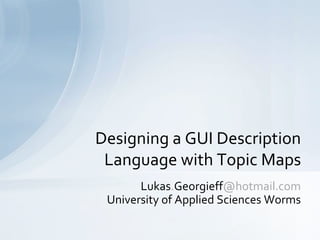Designing a gui_description_language_with_topic_maps
- 1. Designing a GUI Description Language with Topic Maps Lukas.Georgieff@hotmail.com University of Applied Sciences Worms
- 2. Topic Maps (1) ŌĆó ŌĆ£Information wants to be freeŌĆ£ ŌĆó ŌĆ£Information wants to be a topic mapŌĆ£ 30/09/2010 Lukas Georgieff - TMRA 2010 - GDL 2
- 3. Topic Maps (2) ŌĆó ŌĆ£Information wants to be freeŌĆ£ ŌĆó ŌĆ£Information wants to be a topic mapŌĆ£ 30/09/2010 Lukas Georgieff - TMRA 2010 - GDL 3
- 4. Topic Maps (3) ŌĆó ŌĆ£Information wants to be freeŌĆ£ ŌĆó ŌĆ£Information wants to be a topic mapŌĆ£ 30/09/2010 Lukas Georgieff - TMRA 2010 - GDL 4
- 5. Topic Maps (4) ŌĆó ŌĆ£Information wants to be freeŌĆ£ ŌĆó ŌĆ£Information wants to be a topic mapŌĆ£ Why? ŌĆō TM models arbitrary real world scenarios ŌĆō TM knows no limits for users But users must be familiar with TM-internals 30/09/2010 Lukas Georgieff - TMRA 2010 - GDL 5
- 6. Topic Maps (5) What to do? 30/09/2010 Lukas Georgieff - TMRA 2010 - GDL 6
- 7. GDL (1) ’āĀ GUI Description Language, a TM ontology ŌĆó Goals ŌĆō Generic UI adapted to a specific domain ŌĆō Configurable UI ŌĆō Plattform independency ŌĆō ŌĆ£Semantic basedŌĆ£ ŌĆō Non-limitting for TM ŌĆō Simplifying TM for end users 30/09/2010 Lukas Georgieff - TMRA 2010 - GDL 7
- 8. GDL (2) 30/09/2010 Lukas Georgieff - TMRA 2010 - GDL 8
- 9. GDL ŌĆō Features (1) ŌĆó Defines default values e.g. PSIs regexp: ŌĆ£http://some.where/psis/author/.+ŌĆ£ ŌĆó Allows to hide fields e.g. item identifiers ŌĆó Auto-generates (sub-)values e.g. item identifiers a predifened prefix with an auto- generated suffix ŌĆó Defines restrictions for end users e.g. no creation of elements, just a choice of elements 30/09/2010 Lukas Georgieff - TMRA 2010 - GDL 9
- 10. GDL ŌĆō Features (2) ŌĆó Allows individual layout of TM-constructs corresponding to semantic meaning/domain e.g. placing, naming, visual construction of elements on screen, using of css ŌĆó Binds/displays partial modelled data at one glance e.g. displaying topics related via associations ŌĆó Generates context depending GUIs e.g. visualisation depends on the area of interest 30/09/2010 Lukas Georgieff - TMRA 2010 - GDL 10
- 11. GDL ŌĆō Features (3) 30/09/2010 Lukas Georgieff - TMRA 2010 - GDL 11
- 12. GDL ŌĆō Features (4) 30/09/2010 Lukas Georgieff - TMRA 2010 - GDL 12
- 13. GDL ŌĆō Features (5) 30/09/2010 Lukas Georgieff - TMRA 2010 - GDL 13
- 14. GDL - Problems ŌĆó GDL inserts a new layer between the end user and the TM-engine ŌĆō Additional processing of the GDL-data ŌĆō GDL-file must be created ŌĆō Many GUI-systems exist ŌĆō GDL exists in parallel with TMCL 30/09/2010 Lukas Georgieff - TMRA 2010 - GDL 14
- 15. Conclusions ŌĆó GDL builds a bridge between the end-user and the TM-internals ŌĆó GDL does not limit TM/ontology ŌĆó GUI is not hard-coded but still configurable ŌĆó GDL is not plattform/TM dependent ’āĀ defines just the semantics 30/09/2010 Lukas Georgieff - TMRA 2010 - GDL 15
- 16. Thank you for your attention! 30/09/2010 Lukas Georgieff - TMRA 2010 - GDL 16















